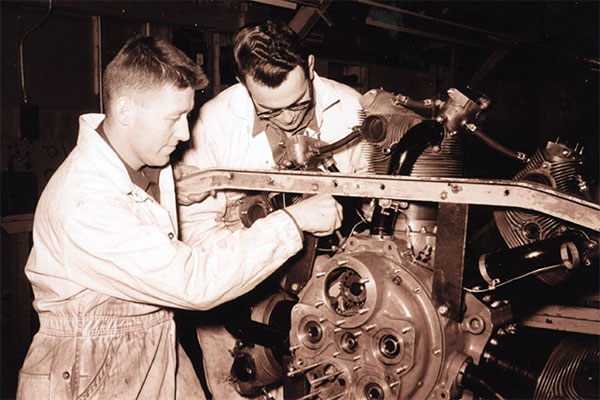Time capsules on campus
Time capsule: 1966
SAIT has a healthy obsession with time capsules in its 100-year history, with four different time capsules being put underground between 1966 and 2016.
For SAIT's 50th Anniversary in 1966, a solid metal box was welded on campus and buried under a rock to be sealed in concrete until our Centennial celebration, held in 2016.
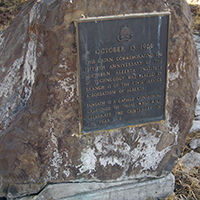
Time capsule: 1991
In 1991, we hosted our 75th homecoming celebration which was a PVC pipe buried in the centre of campus, holding memories and mementoes from a single weekend Alumni event.
In 2036, the time capsule commemorating 50 years of the Walker Building will be opened. This time capsule was dedicated to the staff and students of the Southern Alberta Institute of Technology.

Time capsule: 2016
As part of the Centennial Celebration, the staff and faculty put together a new time capsule which will be opened in 2116.
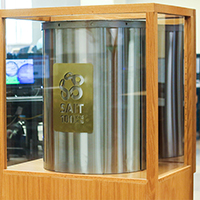
Historical highlights
Alberta becomes a province; both Calgary and Edmonton campaign to become the capital city before Edmonton is granted the honour. Soon after, Strathcona is deemed the location for the province's first university, the University of Alberta. Calgary is outraged and begins lobbying for its own university.
The provincial government grants permission to open Calgary College, though it is a privately-funded university and cannot legally grant degrees.
Calgary College closes due to its inability to grant degrees and also as a result of the First World War, leading to low enrolment and lack of funding. Ontario and Western Canada had provided most of the soldiers that set sail one year earlier as part of the First Contingent, the first Canadian troops to go to war. Many of them did not return.
Soldiers return to Canada in desperate need of vocational training in order to lead productive civilian lives. The federal government agrees to help finance a new institute on the condition that training facilities were available to the Federal Military Hospitals Commission.
 Located in Inglewood's Colonel Walker School as well as the adjacent police and fire stations, the Provincial Institute of Technology and Art (PITA) opens its doors with courses in metalworking and motor mechanics on Oct. 16, 1916.
Located in Inglewood's Colonel Walker School as well as the adjacent police and fire stations, the Provincial Institute of Technology and Art (PITA) opens its doors with courses in metalworking and motor mechanics on Oct. 16, 1916.
Classes began with 11 students — six veterans and five civilians — and seven staff. The equipment list is humble — two lathes, two drill presses, one forge, one motorcycle and one automobile.
Within two weeks, 370 students enrolled in day programs, evening classes and Saturday morning classes and correspondence courses. Soon, PITA would be retraining so many returning soldiers from World War 1 that civilian instruction was suspended for two years.
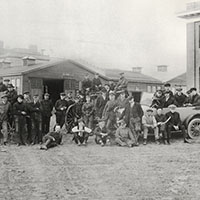 On Oct. 2, 1918, the first cases of the devastating Spanish Influenza Epidemic are reported in Calgary. Although the ill are taken to an isolated hospital, the number of cases across the city rises rapidly.
On Oct. 2, 1918, the first cases of the devastating Spanish Influenza Epidemic are reported in Calgary. Although the ill are taken to an isolated hospital, the number of cases across the city rises rapidly.
On Oct. 24, the Calgary Health Department seizes PITA's temporary campus under the orders of the Provincial Department of Health and converts it to a flu hospital for a month.
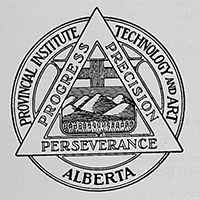 The Province purchases the 110-acre Riley farm as a permanent home for PITA for a cost of $63,000 dollars.
The Province purchases the 110-acre Riley farm as a permanent home for PITA for a cost of $63,000 dollars.
Mr. Thomas E. Riley donates additional land for the construction of the Main Building (Heritage Hall) in return for the Province pardoning the $30,000 dollars he owes in back taxes.
 PITA opens to civilian students once again, just two years before it is to move to its permanent North Hill location. Correspondence courses flourish this year, along with outreach night school programs to rural areas.
PITA opens to civilian students once again, just two years before it is to move to its permanent North Hill location. Correspondence courses flourish this year, along with outreach night school programs to rural areas.
 SAIT's now 101-year-old alumnus Clarence Hollingworth witnesses the laying of the cornerstone for the Main Building (Heritage Hall) as a 6-year-old boy. Hollingworth later attended PITA as an electrical student. During the war, he spent two-and-a-half years in a submarine, in some instances working on highly confidential missions. He became a PITA instructor in 1952, retiring in 1980. Hollingworth is a 2015 SAIT Honorary Bachelor of Science recipient.
SAIT's now 101-year-old alumnus Clarence Hollingworth witnesses the laying of the cornerstone for the Main Building (Heritage Hall) as a 6-year-old boy. Hollingworth later attended PITA as an electrical student. During the war, he spent two-and-a-half years in a submarine, in some instances working on highly confidential missions. He became a PITA instructor in 1952, retiring in 1980. Hollingworth is a 2015 SAIT Honorary Bachelor of Science recipient.
SAIT forms its first Athletics Association. Basketball is the only sport played with teams outside of the institution; however, other sports would soon follow.
PITA moves to its new home — a stately castle on the north hill of Calgary, coined the Main Building, a Power Plant (now the Eugene Coste Building) and the "A" Shops. PITA shared the space with the provincial Normal School's Calgary branch.
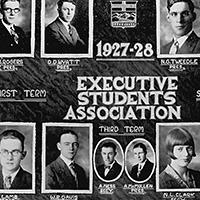 The first Students' Association is formed in order "to control activities outside of the shop and classroom." It costs to join and promotes literary, athletic and social activities.
The first Students' Association is formed in order "to control activities outside of the shop and classroom." It costs to join and promotes literary, athletic and social activities.
The first Emery Weal student newspaper is published on March 18, 1926.
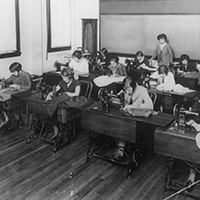 PITA forms a dedicated art department. The department would eventually become its own art and design college, known today as Alberta College of Art and Design, after separating from PITA in 1985.
PITA forms a dedicated art department. The department would eventually become its own art and design college, known today as Alberta College of Art and Design, after separating from PITA in 1985.
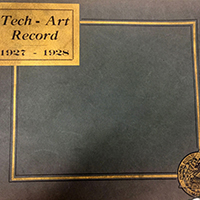 The first student yearbook is published by the Tech Students' Association, it is known as the Tech-Art Record.
The first student yearbook is published by the Tech Students' Association, it is known as the Tech-Art Record.
A hot lunch costs 25 cents in the school cafeteria.
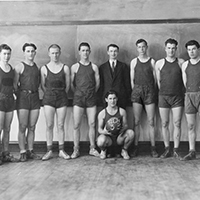 SAIT was not immune to the effects of the Great Depression and even offered tuition-free evening courses to the unemployed, taught by SAIT instructors on a voluntary basis. PITA's cafeteria supports the community by offering relief lunches to women and children in need. Music, drama, athletic and hobbies flourished, as these were opportunities most students could afford.
SAIT was not immune to the effects of the Great Depression and even offered tuition-free evening courses to the unemployed, taught by SAIT instructors on a voluntary basis. PITA's cafeteria supports the community by offering relief lunches to women and children in need. Music, drama, athletic and hobbies flourished, as these were opportunities most students could afford.
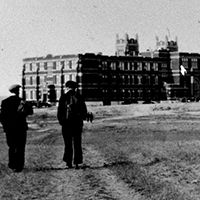 As the end of the depression neared, more and more students enrolled and in 1936, SAIT revived its evening class program.
As the end of the depression neared, more and more students enrolled and in 1936, SAIT revived its evening class program.
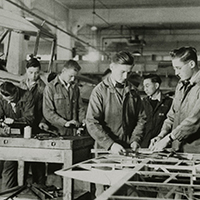 PITA's facilities are taken over by the Royal Canadian Air Force to serve as the No. 2 Wireless Training School of the Commonwealth Air Training Plan. Most regular classes move to the Calgary Stampede Grounds.
PITA's facilities are taken over by the Royal Canadian Air Force to serve as the No. 2 Wireless Training School of the Commonwealth Air Training Plan. Most regular classes move to the Calgary Stampede Grounds.
The art department and women's programs relocate to Coste House, a Mount Royal mansion the city had repossessed for back taxes. The Calgary Normal School moves to King Edward School.
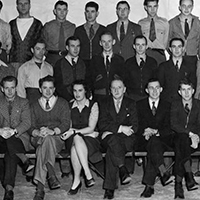 PITA classes return to the North Hill campus. Temporary buildings put up by the RCAF during the war are used by the Government to house homeless veterans.
PITA classes return to the North Hill campus. Temporary buildings put up by the RCAF during the war are used by the Government to house homeless veterans.
The Calgary Normal School also returns to the PITA campus for a short time before becoming a southern extension of the University of Alberta Faculty of Education later that year.

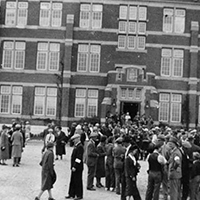 SAIT opens its doors to the public for its first-ever Open House event, an important source of information for those interested in learning about the Institute and the programs it offers. Over 4,000 visitors pass through campus over two days, and the wildly successful event becomes an annual tradition.
SAIT opens its doors to the public for its first-ever Open House event, an important source of information for those interested in learning about the Institute and the programs it offers. Over 4,000 visitors pass through campus over two days, and the wildly successful event becomes an annual tradition.
The first Awards Day is held in the auditorium, scholarships totalling $2,450 are awarded to 15 students in technology programs.
Engineering instructor Alex Higgins is honoured for having his PITA correspondence course materials on Steam Engineering translated into many languages, selling 30,000 copies.
The men's basketball team adopts the Trojans name and the men's hockey team follows suit in 1962.
Go, team! For the first time in history, PITA's cheerleaders are organized for the basketball games.
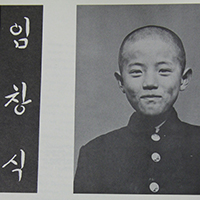 The Students' Association adopts Korean orphan Im Chang Sik and supports him until he can be set up in appropriate housing.
The Students' Association adopts Korean orphan Im Chang Sik and supports him until he can be set up in appropriate housing.
PITA becomes the Southern Alberta Institute of Technology (SAIT), as a result of the Alberta Government opening a similar institution in Edmonton, the Northern Alberta Institute of Technology (NAIT). The art department, although still a part of SAIT, is renamed the Alberta College of Art (ACA).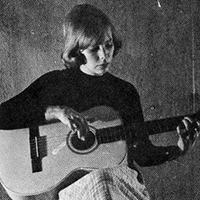
Art student Joni Anderson entertains students at the institution's annual banquet by singing songs and accompanying herself on the guitar.
While living in Calgary, Anderson — famously known as Joni Mitchell — became a regular performer at a club called The Depression. She only spent one year at SAIT before moving to Toronto to be a folk singer, and the rest is history.
Former SAIT instructor Stan Perrot once recalled that Joni, "was determined to succeed in art and did very beautifully I thought. At the same time, she was charging off downtown almost nightly to do her nightclub singing... I called her into my office and questioned her about her career. She said, 'Well, I can't make up my mind what it will be.' And I said, 'I have a feeling you should do one thing to perfection. Either you're going to be an artist — and I think you'll do a superb job — or you're going to be a musician and I think you'll do well there too."
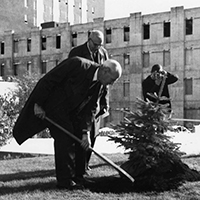 SAIT celebrates its Jubilee by planting a time capsule on the northwest side of campus.
SAIT celebrates its Jubilee by planting a time capsule on the northwest side of campus.
This time capsule was opened on Oct. 16, 2016.
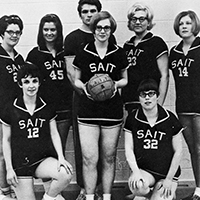 The Trojans and Helenas become the official nicknames of the men's and women's team. The women's athletics teams changed to Lady Trojans in 1988 and dropped "Lady" from their name sometime afterwards.
The Trojans and Helenas become the official nicknames of the men's and women's team. The women's athletics teams changed to Lady Trojans in 1988 and dropped "Lady" from their name sometime afterwards.
Fred Jorgenson, SAIT Principal from 1962 - 1966, returns to campus to become the institute's first President, a position he held until 1984. Jorgenson is celebrated for his hand in the tremendous campus growth that took place through the 70s and early 80s, including facilities, programs and enrolments.
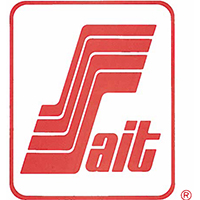 SAIT gets its first logo!
SAIT gets its first logo!
The sweeping "S" of the first design features four bars, representing the four main areas of programming — apprenticeship trades, engineering technologies, applied arts and international education. The line surrounding the SAIT graphic was meant to emphasize the idea of school unity.
 SAIT builds its first student residence, Owasina Hall. The 500-bed residence also serves as a hostel for summer travellers. The hall would close as a residence in 2006 and be used by law enforcement as a training ground until 2015.
SAIT builds its first student residence, Owasina Hall. The 500-bed residence also serves as a hostel for summer travellers. The hall would close as a residence in 2006 and be used by law enforcement as a training ground until 2015.
In 2016, Owasina Hall is in the process of demolition to make space for campus expansions.
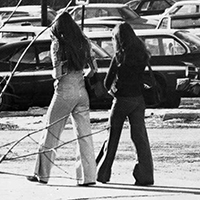 The Tech Students' Association rebrands as SAITSA, which to this day remains unchanged.
The Tech Students' Association rebrands as SAITSA, which to this day remains unchanged.
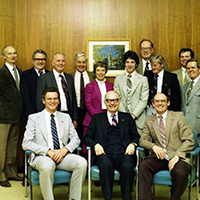 SAIT achieves autonomy from the Alberta Department of Education just as the world price of oil plunged. Though still receiving funding from the Alberta Government, the board of governors assumes responsibility for SAIT's financial wellbeing. As a result, SAIT began a series of fundraising efforts that allow SAIT to flourish to this day.
SAIT achieves autonomy from the Alberta Department of Education just as the world price of oil plunged. Though still receiving funding from the Alberta Government, the board of governors assumes responsibility for SAIT's financial wellbeing. As a result, SAIT began a series of fundraising efforts that allow SAIT to flourish to this day.
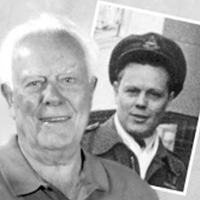 SAIT's Alive is formed — an organization of retired and former SAIT staff — dedicated to preserving and promoting the spirit of friendship and preserving SAIT history.
SAIT's Alive is formed — an organization of retired and former SAIT staff — dedicated to preserving and promoting the spirit of friendship and preserving SAIT history.
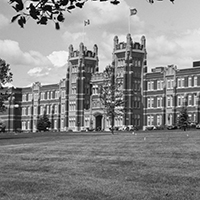 The Main Building is officially renamed Heritage Hall and designated as a National Historic site.
The Main Building is officially renamed Heritage Hall and designated as a National Historic site.
Also in 1985, The Alberta College of Art becomes a separate entity. Its name was later amended to the Alberta College of Art and Design (ACAD) in 1995.
 The CTV Gala Dinner, held on the eve of the 1988 Winter Olympics, is catered by the SAIT Food Services Department and hosted in Campus Centre's Symposium Room.
The CTV Gala Dinner, held on the eve of the 1988 Winter Olympics, is catered by the SAIT Food Services Department and hosted in Campus Centre's Symposium Room.
Notable guests are 1988 Olympic Winter Games mascots Hidy and Howdy, as well as Canadian Prime Minister Brian Mulroney, Mila Mulroney and Governor-General Jeanne Sauvé.
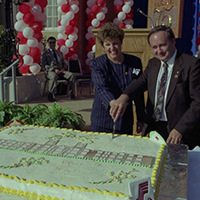 SAIT celebrates its 75th anniversary with more than 500 people gathering on campus to kick off the celebrations.
SAIT celebrates its 75th anniversary with more than 500 people gathering on campus to kick off the celebrations.
Sponsored by the SAIT Alumni Association, the weekend is the largest gathering of SAIT alumni in history... until now.
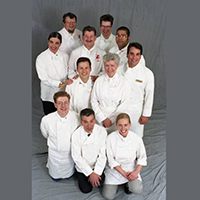 The SAIT Culinary Olympics team heads to Japan to compete.
The SAIT Culinary Olympics team heads to Japan to compete.
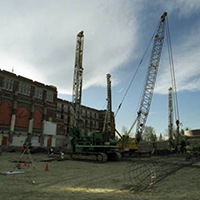 SAIT commits to a cohesive architectural approach that knits the campus into the communities around it, creating an urban academic village.
SAIT commits to a cohesive architectural approach that knits the campus into the communities around it, creating an urban academic village.
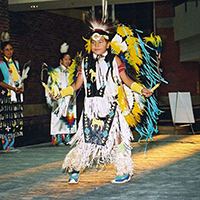 SAIT opens the Chinook Lodge Aboriginal Resource Centre, a cultural bridge between Indigenous and non-indigenous communities, both on campus and in the greater community. It serves as a gathering place dedicated to enriching student life, as well as promoting cultural education and awareness.
SAIT opens the Chinook Lodge Aboriginal Resource Centre, a cultural bridge between Indigenous and non-indigenous communities, both on campus and in the greater community. It serves as a gathering place dedicated to enriching student life, as well as promoting cultural education and awareness.
Construction begins on the 2 million dollars, 106,000 sq. ft Art Smith Aero Centre for Training and Technology, named after one of Calgary's most well-known citizens.
SAIT's International Centre opens!
A much-needed resource, SAIT has hosted students from 162 countries since 2003. By 2015, 1,250 international students are on campus.
 SAIT becomes a founding sponsor of the Skilled Trades and Technologies. Some 150,000 visitors attend WorldSkills and the SAIT campus serves as the Competitors' Village.
SAIT becomes a founding sponsor of the Skilled Trades and Technologies. Some 150,000 visitors attend WorldSkills and the SAIT campus serves as the Competitors' Village.
 SAIT officially opens the doors to its 740,000 sq. ft. Trades and Technology Complex. The 400-million-dollar expansion project is the largest in SAIT's history, adding capacity for an additional 8,100 students.
SAIT officially opens the doors to its 740,000 sq. ft. Trades and Technology Complex. The 400-million-dollar expansion project is the largest in SAIT's history, adding capacity for an additional 8,100 students.
 SAIT is ranked as one of the top research colleges in the country by RE$EARCH Infosource Inc., for its work in Applied Research and Innovation Services (ARIS).
SAIT is ranked as one of the top research colleges in the country by RE$EARCH Infosource Inc., for its work in Applied Research and Innovation Services (ARIS).
Each year, ARIS provides up to 200 students with the opportunity to work collaboratively on industry research projects. More than 575 applied research projects carried out at SAIT have resulted in the development of 400 prototypes.
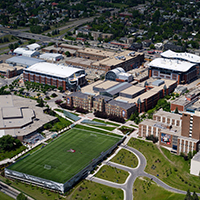 SAIT enters its second century with more than 50,000 full and part-time students and more than 220,000 alumni.
SAIT enters its second century with more than 50,000 full and part-time students and more than 220,000 alumni.
With 84 day-time programs, 37 apprenticeship programs, as well as Continuing Education courses and corporate training offerings, SAIT is a leader in applied education.
Reg Erhardt Library

Oki, Âba wathtech, Danit'ada, Tawnshi, Hello.
SAIT is located on the traditional territories of the Niitsitapi (Blackfoot) and the people of Treaty 7 which includes the Siksika, the Piikani, the Kainai, the Tsuut’ina and the Îyârhe Nakoda of Bearspaw, Chiniki and Goodstoney.
We are situated in an area the Blackfoot tribes traditionally called Moh’kinsstis, where the Bow River meets the Elbow River. We now call it the city of Calgary, which is also home to the Métis Nation of Alberta.
